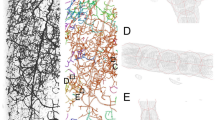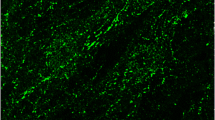Summary
A morphological, karyometric, and quantitative study of cerebral neuroglia and endothelial cells of blood capillaries was done in cirrhotic and in hepatosplenic schistosomotic human autopsied cases. Cluster analysis applied to them revealed three subgroups (cirrhosis and schistosomiasis polar groups and one intermediate). The comparison of these three groups with a control revealed increased numbers of astrocytes, oligodendrocytes and endothelial cells, but no nuclear enlargement in the schistosomiasis group; the cirrhosis group exhibited a pronounced nuclear enlargement of both astrocyte and oligodendrocytes but no increase in cell numbers. The intermediate group, which encompasses the majority of pathological cases, is heterogeneous but on average behave as the cirrhosis group in that nuclear enlargement, but no increase in cell numbers, was noted. Such changes could represent a response of the nervous system to the metabolic disturbances present in hepatic and/or portal-systemic encephalopathy. There was a positive correlation between glial and endothelial cell numbers in cerebral cortex, suggesting a functional relationship between the glial cells and the capillary bed. This study points out the importance of clustering the cases, because the physiopathological status of individuals belonging to the same nosological condition can be different. Comparisons considering this aspect should be useful in understanding the progression of the pathological process.
Similar content being viewed by others
References
Adams RD, Foley JM (1953) The neurological disorder associated with liver disease. Proc Assoc Res Nerv Ment Dis 32:198–237
Bogliolo L (1981) Figado e vias biliares. In: Bogliolo L (ed) Patologia, 3rd edn. Guanabara Koogan, Rio de Janeiro, pp 658–743
Brown IA (1957) Liver-brain relationships. Charles C Thomas, Springfield, Ill, pp 1–198
Cavanagh JB (1974) Liver bypass and the glia. Res Publ Assoc Nerv Ment Dis 53:13–38
Cavanagh JB, Kyu MH (1969) Colchicine-like effect on astrocyte after portacaval shunt in rats. Lancet II:620–622
Cavanagh JB, Kyu MH (1971) Type II Alzheimer change experimentally produced in astrocytes in the rat. J Neurol Sci 12:63–75
Cavanagh JB, Kyu MH (1971) On the mechanism of type I Alzheimer abnormality in the nuclei of astrocytes. An essay in quantitative histology. J Neurol Sci 12:241–261
Diemer NH (1978) Glial and neuronal changes in experimental hepatic encephalopathy. A quantitative morphological investigation. Acta Neurol Scand [Suppl 71] 58:1–144
Diemer NH, Laursen H (1977) Glial cell reactions in rats with hyperammoniemia induced by urease or porto-caval anastomosis. Acta Neurol Scand 55:425–442
Diemer NH, Tonnesen K (1977) Glial changes in pigs with porto-caval anastomosis and temporary or total hepatic artery clamping. Acta Pathol Microbiol Scand [A] 85:721–730
Diemer NH, Klee J, Shröder H, Klinken L (1977) Glial and nerve cell changes in rats with porto-caval anastomosis. Acta Neuropathol (Berl) 39:59–68
Erbslöh F (1958) Das Zentralnervensystem bei Leberkrankheiten. In: Henke F, Lubarsch O, Rössle R (eds) Handbuch der speziellen pathologischen Anatomie und Histologie, vol 13, part 2. Springer, Berlin Heidelberg New York, pp 1645–1698
Floderus S (1944) Untersuchungen über den Bau der menschlichen Hypophyse mit besonderer Berücksichtigung der quantitativen mikromorphologischen Verhältnisse. Acta Pathol Microbiol Scand [Suppl] 53:1–276
Hagen A, Lahl R (1978) Beitrag zur atypischen Makroglia bei nichthepatogenen Erkrankungen. Zentralbl Allg Pathol 122:522–527
Kline DG, Crook JN, Nance FC (1971) Eck fistula encephalopathy: long-term studies in primates. Ann Surg 173:97–103
Lahl R (1967) Zur Häufigkeit astrozytärer Gliaveränderungen (“Leberglia”) bei hepatogenen Erkrankungen, insbesondere Leberzirrhosen, und ihre Abhängigkeit vom Funktionszustand des Organs. Zentralbl Allg Pathol 110:518–545
Lewis AJ (1976) Mechanisms of neurological disease, 1st edn. Little, Brown and Company, Boston, pp 25–53
Martinez-Hernandez A, Bell KP, Norenberg MD (1977) Glutamine synthetase: glial localization in brain. Science 195:1356–1358
Norenberg MD (1977) A light and electron microscopic study of experimental portal-systemic (ammonia) encephalopathy. Progression and reversal of the disorder. Lab Invest 36:618–627
Penfield W (1924) Oligodendroglia and its relation to classical neuroglia. Brain 47:430–452
Pilbeam CM, Anderson RM, Bhathal PS (1983) The brain in experimental portal-systemic encephalopathy. I. Morphological changes in three animal models. J Pathol 140:331–345
Pittella JEH (1981) Astrocytes of the cerebral cortex in hepatosplenic schistosomiasis mansoni and in liver cirrhosis. A morphological quantitative and karyometric study. Virchows Arch [A] 390:229–241
Polak M (1965) Morphological and functional characteristics of the central and peripheral neuroglia (light microscopical observations). Prog Brain Res 15:12–34
Schlote W (1959) Zur Gliaarchitektonik der menschlichen Grosshirnrinde im Nissl-Bild. Arch Psychiat Z Ges Neurol 199:573–595
Sholpo AE (1957) Results of measurement and true dimensions of various spherical histological structures. Arkh Patol 4:75 (cited by Diemer 1978)
Sneath PHA, Sokal RR (1973) Numerical taxonomy. Freeman, London, pp 1–373
Snedecor GW, Cochran WG (1980) Statistical methods, 7th edn. Iowa State University Press, Ames, pp 1–505
Tarnowska-Dziduszko E, Wald I (1971) Study on glial changes in hepato-lenticular degeneration. Pol Med J 10:743–749
Taylor P, Schoene WC, Reid WA Jr, Lichtenberg F (1979) Quantitative changes in astrocytes after portacaval shunting. Arch Pathol Lab Med 103:82–85
Victor M, Adams RD, Cole M (1965) The acquired (non-Wilsonian) type of chronic hepatocerebral degeneration. Medicine (Baltimore) 44:345–396
Zamora AJ, Cavanagh JB, Kyu MH (1973) Ultrastructural response of the astrocytes to portocaval anastomosis in the rat. J Neurol Sci 18:25–45
Author information
Authors and Affiliations
Additional information
Supported by Grants from FINEP (GBF) and from CNPq [nos. 407789/84 (RCG) and 30.2036/76 (JEHP)]
Rights and permissions
About this article
Cite this article
Brasileiro-Filho, G., Guimaraes, R.C. & Pittella, J.E.H. Quantitation and karyometry of cerebral neuroglia and endothelial cells in liver cirrhosis and in the hepatosplenic schistosomiasis mansoni. Acta Neuropathol 77, 582–590 (1989). https://doi.org/10.1007/BF00687885
Received:
Accepted:
Issue Date:
DOI: https://doi.org/10.1007/BF00687885




